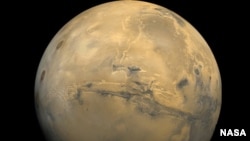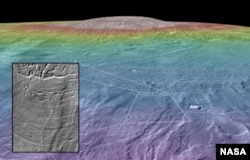It’s nearly two times the height of Mount Everest and one of the largest mountains in the solar system, and new research says if life ever existed on Mars, this could have been one of its last hideouts.
The volcano Arsia Mons, while still active, was covered by an enormous glacier around 210 million years ago, researchers from Brown University say.
The heat from the eruptions on the northwest flank of the giant volcano “would have melted massive amounts of ice to form englacial lakes — bodies of water that form within glaciers like liquid bubbles in a half-frozen ice cube,” according to researchers.
It is a commonly held view that where there’s liquid water, there could be life.
“This is interesting because it’s a way to get a lot of liquid water very recently on Mars,” said Kat Scanlon, a graduate student at Brown who led the study in a statement.
Compared to areas being probed by the various Mars rovers, which are some 2.5 billion years old, the area around Arsia Mons is young.
“If signs of past life are ever found at those older sites, then Arsia Mons would be the next place I would want to go,” Scanlon said.
Scanlon added that on early Mars, there is evidence that many craters were filled with water to depths of hundreds of meters, and were connected by flowing rivers to other crater lakes in long, continuous systems.
“Some or all of these lakes may have been frozen over for some or all of the year, but large aqueous environments existed across a large band of latitudes at that time,” she said in an email to VOA. “210 million years ago, Mars was already in the ‘Amazonian era,’ the current geologic era, and conditions were much like they are today--liquid water wasn't stable at the surface, and probably flowed only in rare, short-lived trickles.”
She added that besides the possibility for underground aquifers, volcanic eruptions into large bodies of ice are one of the few ways large water bodies could come into being in Mars’ Amazonian era.
Since the 1970s, scientists have thought the northwest flank of the giant mountain could have been covered by a giant glacier, which, at its peak size, could have been up to 166,000 square kilometers, said Scanlon.
That theory received a significant boost when researchers showed the area looked “strikingly similar to landforms left by receding glaciers in the Dry Valleys of Antarctica.” The similarities included what appear to be moraines, telltale piles of rocks pushed aside by a moving glacier.
Researchers said some small nearby hills also appear to be formed from glacial debris.
Martian climate modeling also gave researchers reason to think there could have been glaciers on Arsia Mons. During the time in question, Mars would have been at an increased tilt, researchers said. This could have led ice from the polar region to migrate toward the equator.
With compelling evidence that Arsia Mons was covered by a glacier, Scanlon and colleagues from the Lancaster Environmental Centre in the U.K then looked at how volcanic activity would have interacted with the ice.
Using data from NASA’s Mars Reconnaissance Orbiter, they discovered “pillow lava formations” that are similar to what forms on Earth when an underwater volcano erupts. She also discovered “the kinds of ridges and mounds that form on Earth when a lava flow is constrained by glacial ice.”
They also found evidence of a river formed when meltwater trapped in a glacier breaks free.
Using this data, Scanlon and her team were able to calculate how much water the lava in those areas could have produced. At one of the sites, they estimated two lakes containing around 40 cubic kilometers of water each could have been formed. At the other a lake containing around 20 cubic kilometers of water could have existed.
These lakes could have lasted “hundreds or even a few thousand years,” according to the study. That would have been ample time for colonies of microbial life to form if present on the Red Planet.
“There’s been a lot of work on Earth — though not as much as we would like — on the types of microbes that live in these englacial lakes,” Scanlon said in a statement. “They’ve been studied mainly as an analog to [Saturn’s moon] Europa, where you’ve got an entire planet that’s an ice covered lake.”
What happened to all that water?
“Some of the water flowed out from the edge of the glacier and carved channels,” Scanlon wrote. “The rest of the englacial lakes seem to have refrozen in place.”
She added that when the spin-axis tilt of Mars changed, most of the ice sublimed into water vapor and snowed out back at the poles where we see it today.
“Ice is only stable at the equator, where Arsia Mons is located, when Mars's spin-axis tilt is very steep,” she wrote. “Some ice may still be present in the deposit where a thick cover of debris prevents it from subliming.”
A paper describing Scanlon’s work is published in the journal Icarus.
The volcano Arsia Mons, while still active, was covered by an enormous glacier around 210 million years ago, researchers from Brown University say.
The heat from the eruptions on the northwest flank of the giant volcano “would have melted massive amounts of ice to form englacial lakes — bodies of water that form within glaciers like liquid bubbles in a half-frozen ice cube,” according to researchers.
It is a commonly held view that where there’s liquid water, there could be life.
“This is interesting because it’s a way to get a lot of liquid water very recently on Mars,” said Kat Scanlon, a graduate student at Brown who led the study in a statement.
Compared to areas being probed by the various Mars rovers, which are some 2.5 billion years old, the area around Arsia Mons is young.
“If signs of past life are ever found at those older sites, then Arsia Mons would be the next place I would want to go,” Scanlon said.
Scanlon added that on early Mars, there is evidence that many craters were filled with water to depths of hundreds of meters, and were connected by flowing rivers to other crater lakes in long, continuous systems.
“Some or all of these lakes may have been frozen over for some or all of the year, but large aqueous environments existed across a large band of latitudes at that time,” she said in an email to VOA. “210 million years ago, Mars was already in the ‘Amazonian era,’ the current geologic era, and conditions were much like they are today--liquid water wasn't stable at the surface, and probably flowed only in rare, short-lived trickles.”
She added that besides the possibility for underground aquifers, volcanic eruptions into large bodies of ice are one of the few ways large water bodies could come into being in Mars’ Amazonian era.
Since the 1970s, scientists have thought the northwest flank of the giant mountain could have been covered by a giant glacier, which, at its peak size, could have been up to 166,000 square kilometers, said Scanlon.
That theory received a significant boost when researchers showed the area looked “strikingly similar to landforms left by receding glaciers in the Dry Valleys of Antarctica.” The similarities included what appear to be moraines, telltale piles of rocks pushed aside by a moving glacier.
Researchers said some small nearby hills also appear to be formed from glacial debris.
Martian climate modeling also gave researchers reason to think there could have been glaciers on Arsia Mons. During the time in question, Mars would have been at an increased tilt, researchers said. This could have led ice from the polar region to migrate toward the equator.
With compelling evidence that Arsia Mons was covered by a glacier, Scanlon and colleagues from the Lancaster Environmental Centre in the U.K then looked at how volcanic activity would have interacted with the ice.
Using data from NASA’s Mars Reconnaissance Orbiter, they discovered “pillow lava formations” that are similar to what forms on Earth when an underwater volcano erupts. She also discovered “the kinds of ridges and mounds that form on Earth when a lava flow is constrained by glacial ice.”
They also found evidence of a river formed when meltwater trapped in a glacier breaks free.
Using this data, Scanlon and her team were able to calculate how much water the lava in those areas could have produced. At one of the sites, they estimated two lakes containing around 40 cubic kilometers of water each could have been formed. At the other a lake containing around 20 cubic kilometers of water could have existed.
These lakes could have lasted “hundreds or even a few thousand years,” according to the study. That would have been ample time for colonies of microbial life to form if present on the Red Planet.
“There’s been a lot of work on Earth — though not as much as we would like — on the types of microbes that live in these englacial lakes,” Scanlon said in a statement. “They’ve been studied mainly as an analog to [Saturn’s moon] Europa, where you’ve got an entire planet that’s an ice covered lake.”
What happened to all that water?
“Some of the water flowed out from the edge of the glacier and carved channels,” Scanlon wrote. “The rest of the englacial lakes seem to have refrozen in place.”
She added that when the spin-axis tilt of Mars changed, most of the ice sublimed into water vapor and snowed out back at the poles where we see it today.
“Ice is only stable at the equator, where Arsia Mons is located, when Mars's spin-axis tilt is very steep,” she wrote. “Some ice may still be present in the deposit where a thick cover of debris prevents it from subliming.”
A paper describing Scanlon’s work is published in the journal Icarus.











